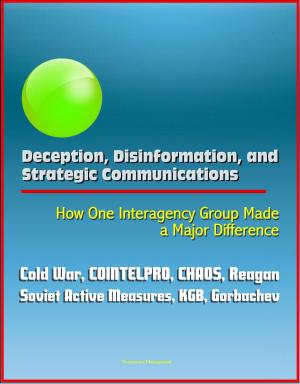Marines in the Korean War Commemorative Series: Frozen Chosin - U.S. Marines at the Changjin Reservoir
Nonfiction, History, Asian, Korean War, Military| Author: | Progressive Management | ISBN: | 9781301132751 |
| Publisher: | Progressive Management | Publication: | January 5, 2013 |
| Imprint: | Smashwords Edition | Language: | English |
| Author: | Progressive Management |
| ISBN: | 9781301132751 |
| Publisher: | Progressive Management |
| Publication: | January 5, 2013 |
| Imprint: | Smashwords Edition |
| Language: | English |
The race to the Yalu was on. General of the Army Douglas MacArthur's strategic triumph at Inchon and the subsequent breakout of the U.S. Eighth Army from the Pusan Perimeter and the recapture of Seoul had changed the direction of the war. Only the finishing touches needed to be done to complete the destruction of the North Korean People's Army. Moving up the east coast was the independent X Corps, commanded by Major General Edward M. Almond, USA. The 1st Marine Division, under Major General Oliver P. Smith, was part of X Corps and had been so since the 15 September 1950 landing at Inchon.
After Seoul the 1st Marine Division had reloaded into its amphibious ships and had swung around the Korean peninsula to land at Wonsan on the east coast. The landing on 26 October 1950 met no opposition; the port had been taken from the land side by the resurgent South Korean army. The date was General Smith's 57th birthday, but he let it pass unnoticed. Two days later he ordered Colonel Homer L. Litzenberg, Jr., 47, to move his 7th Marine Regimental Combat Team north from Wonsan to Hamhung. Smith was then to prepare for an advance to the Manchurian border, 135 miles distant. And so began one of the Marine Corps' greatest battles—or, as the Corps would call it, the "Chosin Reservoir Campaign." The Marines called it the "Chosin" Reservoir because that is what their Japanese-based maps called it. The South Koreans, nationalistic sensibilities disturbed, preferred—and, indeed, would come to insist—that it be called the "Changjin" Reservoir.
General Smith, commander of the Marines—a quiet man and inveterate pipe-smoker (his favorite brand of tobacco was Sir Walter Raleigh)—was not the sort of personality to attract a nickname. His contemporaries sometimes referred to him as "the Professor" but, for the most part, to distinguish him from two more senior and better known General Smiths in the World War II Marine Corps— Holland M. "Howlin' Mad" Smith of famous temper and mild-mannered Julian C. Smith of Tarawa— he was known by his initials "O. P."
Across the Taebaek (Nangnim) Mountains, the Eighth Army, under Lieutenant General Walton H. Walker, was advancing up the west coast of the Korean peninsula. Walker, a short, stubby man, was "Johnnie" to his friends, "Bulldog" to the press. In World War II he had commanded XX Corps in General George S. Patton's Third Army and had been a Patton favorite. But these credentials held little weight with General Douglas MacArthur. He had come close to relieving Walker in August during the worst of the situation in the Pusan Perimeter. Relations between Almond and Walker were cool at best.
The race to the Yalu was on. General of the Army Douglas MacArthur's strategic triumph at Inchon and the subsequent breakout of the U.S. Eighth Army from the Pusan Perimeter and the recapture of Seoul had changed the direction of the war. Only the finishing touches needed to be done to complete the destruction of the North Korean People's Army. Moving up the east coast was the independent X Corps, commanded by Major General Edward M. Almond, USA. The 1st Marine Division, under Major General Oliver P. Smith, was part of X Corps and had been so since the 15 September 1950 landing at Inchon.
After Seoul the 1st Marine Division had reloaded into its amphibious ships and had swung around the Korean peninsula to land at Wonsan on the east coast. The landing on 26 October 1950 met no opposition; the port had been taken from the land side by the resurgent South Korean army. The date was General Smith's 57th birthday, but he let it pass unnoticed. Two days later he ordered Colonel Homer L. Litzenberg, Jr., 47, to move his 7th Marine Regimental Combat Team north from Wonsan to Hamhung. Smith was then to prepare for an advance to the Manchurian border, 135 miles distant. And so began one of the Marine Corps' greatest battles—or, as the Corps would call it, the "Chosin Reservoir Campaign." The Marines called it the "Chosin" Reservoir because that is what their Japanese-based maps called it. The South Koreans, nationalistic sensibilities disturbed, preferred—and, indeed, would come to insist—that it be called the "Changjin" Reservoir.
General Smith, commander of the Marines—a quiet man and inveterate pipe-smoker (his favorite brand of tobacco was Sir Walter Raleigh)—was not the sort of personality to attract a nickname. His contemporaries sometimes referred to him as "the Professor" but, for the most part, to distinguish him from two more senior and better known General Smiths in the World War II Marine Corps— Holland M. "Howlin' Mad" Smith of famous temper and mild-mannered Julian C. Smith of Tarawa— he was known by his initials "O. P."
Across the Taebaek (Nangnim) Mountains, the Eighth Army, under Lieutenant General Walton H. Walker, was advancing up the west coast of the Korean peninsula. Walker, a short, stubby man, was "Johnnie" to his friends, "Bulldog" to the press. In World War II he had commanded XX Corps in General George S. Patton's Third Army and had been a Patton favorite. But these credentials held little weight with General Douglas MacArthur. He had come close to relieving Walker in August during the worst of the situation in the Pusan Perimeter. Relations between Almond and Walker were cool at best.















